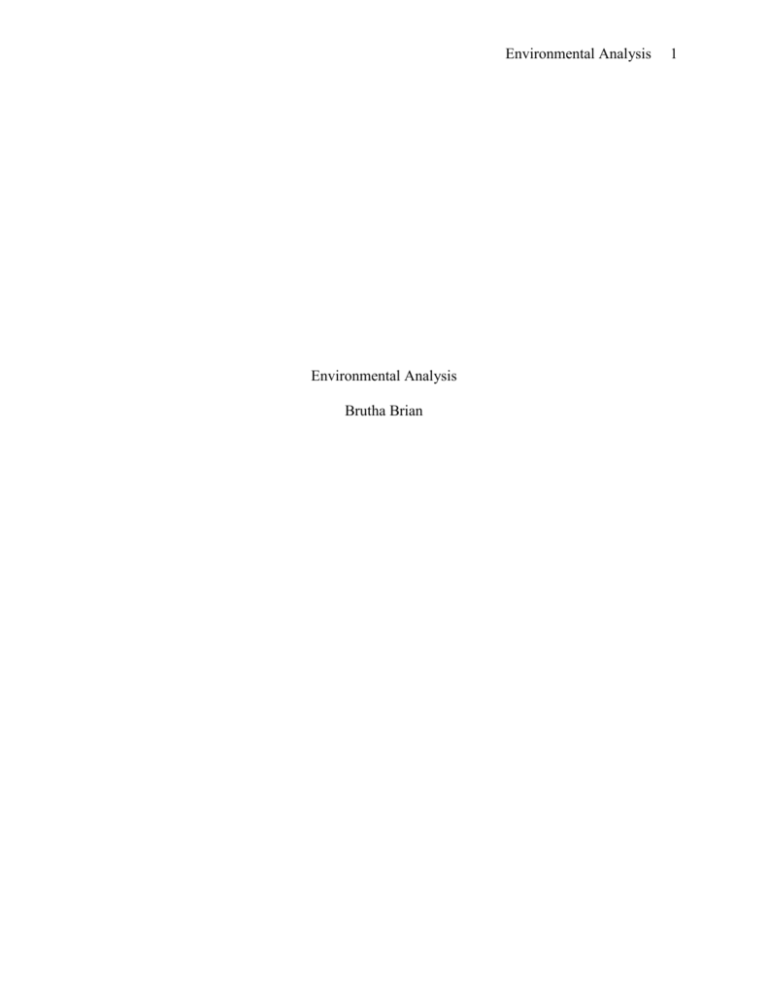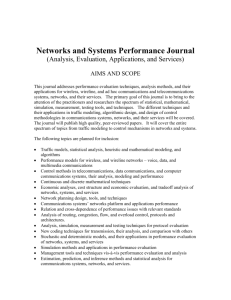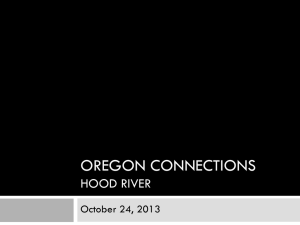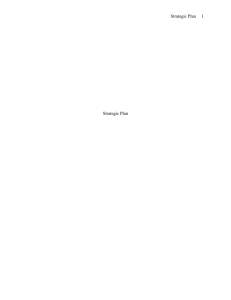Environmental Analysis - Getting going with life-Take care
advertisement

Environmental Analysis Environmental Analysis Brutha Brian 1 Environmental Analysis 2 (Industry) “A host of external factors influence a firm's choice of direction and action and ultimately, its organizational structure and internal processes” (Pearce et al., 2004). Environmental scanning is essential when formulating a strategic plan, and should involve detailed research to optimize leverage points. This paper will discuss important environmental factors, while addressing operational plans designed to increase sustainable competitive advantage. AT and T will benefit by working from a formulation guideline governed according to the global forecasts, economic assessments, and competitive forces. Management will want to prepare the strategic plan considering company strengths/weaknesses in order to survive industry challenges and improve positioning. While conducting an internal analysis, strategists will have to determine the collective effect of forces such as barriers to entry, rivalry elements, supplier power, substitution, a buyer power. Though the firm may possess strength in one area, weaknesses in any of them are potentially threatening to returns and sustainability. To some experts, buyer power is the strongest force to be aware of. Though this is possibly the case in the oil industry, every sector is different. For example, AT and T had benefited from strong market leadership for a long time until the Department of Justice forced the Baby Bells to be born. After this event, the firm experienced new substitution challenges. In addition, as the telecommunication industry evolves, other business sectors are becoming forums for competition. Wireless communication continues to replace landlines, which is forcing AT and T to encourage employees to innovate and leverage synergies. Entry barriers such as economies of scale, brand identity, and cost advantages all benefit AT and T. Since the merger with SBC, the firm has improved strategic positioning and expanded Environmental Analysis 3 market share by offering bundled services. Brand identity has also reinforced market presence as the exclusive iPhone contract has continued. Though the iPhone contract will be expiring, new product/services offerings are set to contend with competition in the wireless, internet and entertainment market. Integration will become the future focus for all telecommunications companies. Consumers are seeking greater connectivity, mobility, and speed. Traditional views of strategy are changing globally. Therefore, knowledge of forces and trends are the key to preparation. Long-term goals should be established based on how technological evolution will be shaped by consumer needs, and the scope of products/services. Once trends and forces are assessed, appropriate criteria will need to be developed to best reflect the importance weights. In addition, differentiation, focus, and cost leadership is necessary when competing for market share. “In fact, the hundred largest U.S. globals earn an average of 37% of their operating profits abroad. Equally impressive is the impact of foreign-based globals that operate in the United States” (Pearce et al., 2004). According to Euromonitor International, the strongest emerging markets will be India and China. New technology, greater efficiency, and free-market practices pose challenges to current global telecommunications companies. Increases in prioritization are said to be creating new pressures that AT and T plans to confront with better strategy, resource allocation and efficiency. Global forces are changing the telecommunication sector in a way that requires advanced proactive approaches. Increased focus on contingency planning that considers the complexity of political and financial environments will have to be applied. Important trends are the building world financial value, expanding urban areas, Internet use, population growth rates, Environmental Analysis 4 demographics, working people/retiree ratios, and income/education gaps. These factors should have an effect on strategic decision-making. AT and T is a global corporation that must be able to pinpoint appropriately optimal areas for targeting resources and satisfying stakeholders. Sustained competitive advantage is possible only when global forces are analyzed for insight on issues such as consumer demand and accessibility. The firm has existed throughout the evolution of the telephone into wireless technology, and continues to update plans according to expected market needs based upon aggregate analysis and innovative thinking. Another effective way of dealing with changing trends in sector forces is by recognizing the value of multi-domestic structuring. “A multidomestic industry is one in which competition is essentially segmented from country to country. Thus, even if global corporations are in the industry, competition in one country is independent of competition in another country” (Pearce et al., 2004). Emphasis on subsidiary autonomy becomes a priority when using multidomestic approaches. Every country is a different combination of interdependencies which creates varied manifestations of forces and trends. Therefore, global thinking should be organized in a way that allows for accurate subsidiary identities. One of the articles from the course readings provides an interesting view of market competition. The primary theme of the article is focused around how to create market space instead of always allowing decisions to be competition driven (Blue oceans vs. Red Oceansbloody water). “Blue oceans denote all the industries not in existence today-the unknown market space, untainted by competition. In blue oceans, demand is created rather than thought over” (Chan et al., 2004). Relevant forces and trends become more understandable within the blue Environmental Analysis 5 ocean strategy. This kind of thinking attempts to eliminate common cognitive barriers that limit organizations. Reorienting management thought patterns is the new way of dealing with traditional forces and trend definitions. Trade-offs between differentiation and cost can be dealt with simultaneously. When strategy is infused with value leaps, competition becomes less of a pressure and employees are more enthusiastic and productive. For an organization such as Cirque du Soleil, imitation is less of a concern. Therefore, strategists at A T and T should investigate this refreshed approach. Regardless of the philosophy a firm uses to deal with competitive forces, all profit based corporations seek sustained competitive advantage. According to the course readings, primary focus should be directed towards differentiation and cost structure. Companies such as Disney and Wal-Mart successfully deliver products and services that display differentiation/cost leadership strengths that consistently maintain market leadership. Both firms also experience above-average profitability by realizing the importance of these targeted strategy combinations. Most businesses usually possess one or the other, which results in unbalanced performance within the industry. Companies traditionally emphasize one type of generic strategy; however, an updated firm will know the value of integrated practices. Opportunities for both cost-leadership and differentiation should be strategically analyzed for leverage areas. Choosing to investigate these elements in the market will help identify critical success factors that lead to competitive advantage. Environmental Analysis 6 (Remote Environment) Organizational systems are cyclical (nonlinear). This means processes are involved in feedback loops influenced by internal and external factors. When developing a strategic plan, management should remember that non-economic elements exist that greatly affect the system activities and how they must be oriented. Knowledge of the remote environment teaches strategists which points to leverage, and which to limit. In a sense, the firm is a metaphorical boat/ship that must have a strong rudder placed correctly to navigate the market waters. Education on major global trends creates a pervasive understanding of how the firm connects with the world. In addition, management should proactively charge themselves with the responsibility of expanding capacity to learn about global trends to build realistic policies. Emphasis should be placed not only on events, but the underlying causes that create change. Transparency and relevance must be infused with productivity for successful strategic planning. “All to often, ‘proactiveness’ is reactiveness in disguise. If we simply become more aggressive fighting the ‘enemy out there’, we are reacting-regardless of what we call it” (Senge, pg 21). Global trends are often non-obvious directions to that manifest themselves in consumer behavior. In telecommunications, the industry is greatly affected by an aging generation, urbanization, migration, home entertainment, and convenience. For example, many companies are targeting both senior and youth groups, limiting investments where political instability exists, increasing R and D for home entertainment products and services, and expanding offerings that leverage wireless market interests. In both developing and developed countries, many people are retiring later due to diminishing dependency ratios (working/non-working). This fact is causing governments to consider initiating incentives for working women, migrant workers, and delayed retirees. With a population of senior consumers increasing, AT and T is going to have to target Environmental Analysis 7 strategy accordingly. An interesting forecast is that by 2015 in Japan, 23.3% of the population will be over 65 years old (Euromonitor International, pg 5). In other countries; Australia: by 2020, the average life expectancy will be approximately 85 years old, in Germany-unemployment continues to grow and falling birth rates are inspiring incentives for family expansion, in the Netherlands-by 2027 the death rate will surpass the birth rate, in China/India-emerging markets are stimulating enormous international capital flows and a growing middle class (Euromonitor International, pg 7). Every region/country is experiencing different cycles of technology. The reports from Euromonitor explain that a widening gap is occurring between developing countries (increased needs) and developing (biotechnology). In addition, income chasms are on an uptrend, and more visible due to greater Internet use. With advances in the agricultural industry, modified crops will be sufficient to meet developing country needs and are less available due to distribution problems (by 2015). Government control and social conflict is also preventing efforts to provide assistance. The fact that 80% of the planet water usage is for agriculture, and resources are not sustainable, many countries will be experiencing lowering levels of irrigation potential. A startling fact is that farmers in China have experienced tremendous loss from reduced government expenditures (lower than 1978), and a large portion are near poverty. Good news is that as of 2005, agricultural taxes were eliminated and education is now free in rural areas. Another fascinating statistic is that Chinese farmers represent 60% of the 1.3 billion population. Outsourcing is big business in the world today and not only for call centers and manufacturing. India is becoming a focal point for R and D/software as well as China and the Philippines. In fact, some Russian outsourcing experts are concerned that Asia will be replacing Environmental Analysis 8 outsourcing that is currently placed in Europe and Russia. According to Euromonitor, Europe will outsource one million jobs the next 10 years. “Over the next decade a wide range of developments will lead to many new IT-enabled devices and services. Rapid diffusion is likely because equipment costs will decrease at the same time that demand is increasing” (Euromonitor International, pg 18). As global Internet access is expanding, mobile phone connectivity is increasing and with reduced cost. Studies have shown that Internet usage is growing immensely and most people are finding new ways to replace previous department store shopping, music purchases, and tourism functions. (Operating Environment) Operating environments drive a company, and should be carefully maintained. AT and T strengths would include a 37.2% increase in wireless data revenues, the success of the iPhone launch, and continued U-verse subscribership growth. Weaknesses would include the loss of revenues from landline usage, the iPhone contract expiration, and lack of sufficient consumer retention compared to Verizon. “Technological change is one of the principal drivers of competition. It plays a major role in industry structural change, as well as creating new industries” (Porter, pg 64). AT and T has experienced an erosion of market leadership as a result of the anticompetitive enforcement and increased Verizon dominance. For many years, AT and T maintained a prominent role, and will have to use aggregate trend analysis to prepare for high technology changes occurring at home and abroad. Focus will have to center on core industry elements that benefit the long term such as the internet, connectivity and mobility. Environmental Analysis 9 Knowing how to connect long-term strategies to innovation/consumer value will lead to competitive advantage. Management has a responsibility to identify critical success factors that can be leveraged to achieve structural sustainability. Since technology is the core of the telecommunications industry, competitive advantage will rely upon how well A T and T can deliver innovation and functionality simultaneously. The operating environment can be optimized by using value chain analysis. Each department combines to create a unified entity that can be broken down into distinct value building components. Strengths and weaknesses of an organization will vary according to how well employees can leverage critical value chain activities. AT and T will have to communicate the importance of this focus, while differentiation and cost leadership becomes a priority. Improving operations requires growth from the inside out. Most corporations are learning that change occurs when the organization is aligned at all levels. If management is not thoroughly committed to identifying realistic long-term success drivers, then decisions will lead to operational decline. While conceptual structures need to be re-oriented, data reliance must also be geared to measure consistency of results. Activity should connect long-term goals, and assessments should be accepted and built into the framework. Integration is the future. Employees at A T and T must be encouraged to join Internet forms that discuss activity relevance. In addition, staff should discover how to update processes in order to increase stakeholder value. Change can be very challenging for traditional organizations such as A T and T. Leaders must learn to find balance between stability and the need to create value building opportunities at all levels of the firm. Operational disciplines and perceptions must manifest through behaviors, and evolve along as company employees gain new understanding of how to prioritize objectives. Strategic plans should be designed to leverage Environmental Analysis 10 strengths, while empowering operations to identify needed change through ongoing competitive advantage assessments. Operations strength at AT and T relies upon how well management can recognize competencies and limits within each department. Management must be able to consistently communicate the importance of cross-functional linkage to protect activities from value erosion. “Standing forward to do battle with these dilemmas and disabilities is ‘the management team’, the collection of savvy, experienced managers who represent the organization’s different functions and areas of expertise. Together, they are supposed to sort out the complex crossfunctional issues that are critical to the organization” (Senge, pg 24). Former policies have to be rewritten in order to address new ways of improving operations in the fast-growing telecommunications industry. According to an AT and T financial review (2008), success in the wireless industry will depend on the company ability to capture operating trends such as increased services innovation, upgrades, and minimized consumer turnover. As of 2008, wireless operating income margin was 22.5%, which is expected to increase from cost advantage and consumer gains (AT and TFinancial Review, 2008). Competition has challenged the firm as customers are changing from wireline to technologies such as wireless and voice over Internet protocol (VOIP). As the environment becomes more competitive, and the global economy fluctuates, AT and T expects operational revenues expansion. Branding products/services offerings continue to gain overwhelming consumer support with wireless becoming the primary driver. Traditional land lines will gradually fade, and revenues from bundled broadband services will increase. Incomes from operating margins are expected to remain relatively stable despite industry wide competition. In the U.S., government agencies have been working on bringing strength to Environmental Analysis 11 financial systems, which should only help AT and T build better relationships with consumers. Due to the weakness in the global economy, the company has experienced variations in consumer bases, which have been well mitigated by customer additions. Demand fluctuations in one segment are offset by increased interest in wireless products. Wireless industry experts expect the majority of revenues to be derived from a combination of wireless, broadband, VOIP and video offerings. Regardless of economic conditions, a growth period is occurring in telecommunications. AT and T is planning on net worth growth from consumer response along with greater innovation and service upgrades. (Long Term Objectives) Management should consistently work to align the company mission with activities. This process involves strategic planning that centers on necessary long-term objective identification to achieve sustainable prosperity. Most of the problems with organizations involve short-term profit perspectives that jeopardize stakeholder relationships. When determining long-term objectives, firms often emphasize productivity, competitive position, employment development, employee relations, technological leadership, and public responsibility (Pearce et al., 2004). Productivity goals are often expressed through efficiency. Due to the advances in technology, AT and T is able to take advantage of scalability and multiregional manufacturing facilities. Tremendous opportunity exists by using realistic forecast techniques and macroenvironment analysis to guide decision-making. When a company such as AT and T optimizes economies of scale and efficiency, competitive positioning is possible yet contingent upon how well strategists activate viable Internet capabilities within the wireless market. Environmental Analysis 12 Employee development and employee relations are essential for long-term objectives to succeed. Evolved organizations will realize that valuing education and relationships should be primary concerns. GE, Motorola, and AlliedSignal are strong examples of how continuing education has established connections between employee development and prosperity. AT and T has already established itself as a technology leader. Now that the firm has set precedence for bundled services (U-verse), the world will expect only brilliant product/service offerings. The key to sustainable net worth growth depends on how well the firm competes for wireless and bundled services market share. While every firm in the telecommunications market is battling for control of mobile phone customers, the Green movement is also pressuring firms to establish public responsibility. As the next 10 years of exponential technology advances accelerate innovation, AT and T plans to increase global awareness of how telecommunications will help change the world in a positive way. Primary long-term objectives for AT and T are a minimum of 4% annual wireless revenues growth, 7% annual U-verse subscriber base growth, reach over 100 million wireless subscribers within five years, and 17% annual revenues increase for broadband wireless services. These goals are achievable, considering the booming industry, and attainable as a result of the newly aligned strategic management perceptions. (Mission Statement) An organizational mission is becoming increasingly important to consumers in the telecommunications industry. AT and T is part of a global Green movement that is helping transform the consciousness of the people, therefore, the company mission statement should reflect that commitment to change. Strategic business revenues continue to grow for the Environmental Analysis 13 company, while the divisions between income classes widen. Trends of news organizations to report global equality gaps are increasing, and firms are increasingly making efforts to address these issues. Consumers should know that AT and T is organizing efforts to increase consumer value while enhancing profitability. Capital gains should translate into benefits for all stakeholders. The first line in the AT and T mission statement begins with: “AT and T's mission statement: we aspire to be the most admired and valuable company in the world” (At and T.com/history). A more customer friendly statement was part of the second section. “Our goal is to enrich our customers personal lives and to make their businesses more successful by bringing to market exciting and useful communication services, building shareholder value in the process” (AT and T.com/history). Stakeholders are sensitive to how companies word mission statements, and generally the first impression communicates long-term perceptions. Each stakeholder group possesses different needs, and creating an appropriate image requires the inclusion of a unifying purpose to help strengthen loyalty. Mission statements often include three components: product/service specifications, market targets, and principal technology (Pearce, 2004). In addition, the statement should convey a long-term commitment to survival, profitability, and growth. Communicating an overarching purpose is essential to building a sustainable organization. People are the pulse of a company, and employee/consumers should perceive the organizational attempt to increase value. Understanding the voice of stakeholders involves exploring underlying needs, and management must proactively gain a responsibility to protect the covenant expressed in the mission statement. From the words of Mr. Inamori, founder of Kyocera, leaders must “give up the old dogma of planning, organizing and controlling, and Environmental Analysis 14 realize the almost sacredness of their responsibility for the lives of so many people” (Senge, pg 140). New trends in organizational mission statements are influencing how firms are developing overarching themes. Common elements are emphasizing consumer needs, and higher hopes. Firms such as General Electric and Johnson and Johnson have made leaps in communicating the importance of consumer satisfaction. A clear sense of organizational purpose should be considered an important part of establishing long-term strategic objectives. When the mission is clearly established, management will have to identify which levers need the most attention. Levers such a structure, leadership, and culture are important areas to analyze. Traditional structures need to be updated in order to maximize the effectiveness of cross functional collaboration, and transparency. By launching refreshed initiatives that align with the overarching mission, stakeholders will experience growing interdependent relationships. Environmental Analysis 15 References AT and T Annual Report 2008. Retrieved July 30, 2009 from AT&T.com Chan, Kim W. Blue Ocean Strategy. Harvard Business Review; October 2004, Vol. 82 Issue 10, p76-84, 9p, 2 charts,1. Retrieved from eResource page MBA-580-University of Phoenix. Euromonitor International- Reports. Forty key Trends for the Next Decade: 20 Key Global Trends and 20 Key Consumer Trends 2005-2015. Retrieved July 31, 2009 from University of Phoenix Library. Gray, C.F., & Larson, E.W. (2006). Project Management: The Managerial Process. [Electronic version] (3rd ed.). New York, New York: The McGraw-Hill Companies. Pearce, Jack. Robinson, Richard.(2004). Strategic Management: Formulation, Implementation, and Control, 9e. New York. New York. The McGraw Hill Companies. Plunkett Research Online: Telecommunications: Introduction to the Telecommunications Industry. Retrieved July 31, 2009 from University of Phoenix Library. Porter, Michael E., Competitive Advantage. (1985) The Free Press, A Division of Simon and Schuster Inc. New York. New York. Environmental Analysis 16 Pyzdek, T. (2003). The Six Sigma Handbook. McGraw-Hill Companies. New York. Redback Networks Announces Top 5 Telecommunications Trends for 2009. Anonymous. Business Wire. New York: December 17, 2008. Retrieved July 30, 2009, from ProQuest. Senge, P., M. (1990). The Fifth Discipline. New York, New York. Bantam Doubleday Dell Publishing Group.







